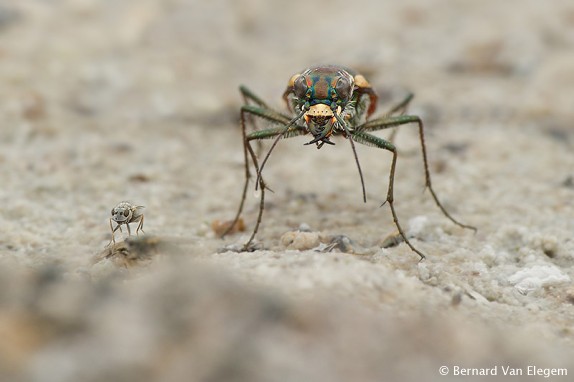Time to start worrying, Brine Fly stalked by Westsalts Tiger Beetle - Oevervlieg belaagd door Zandloopkever - Ephydra cinerea, Cicindela hemorrhagica
During the summer or early fall billions of Brine Flies occur along the shoreline of Great Salt Lake in Utah. While their numbers are intimidating, brine flies aren't interested in humans. They will get out of the way if disturbed, and they tend to stay close to the ground near the edge of the lake. Brine flies live most of their lives underwater. Their life cycle begins in the summer, when the female flies lay their eggs on the water surface. After the eggs hatch, the larvae graze near the lake bottom. They eat mostly cyanobacteria, but their diet also includes other types of bacteria, bottom-dwelling algae, diatoms, and detritus. They prefer to live in muddy areas or on bioherms rather than in sandy areas. After one to a few weeks (depending on the water temperature) the adults emerge from their pupal casing andsalt lakes, great salt lake, float to the surface. Adults live for only a few days, just long enough to mate and lay eggs. If food is plentiful and temperatures remain high, brine flies can complete two life cycles in one season. After the adult brine flies hatch, pupal casings are blown about by the wind. The brown casings pile up in often miles-long masses along the shoreline. In fact, the Utah Division of Wildlife Resources counted 7 billion pupal casings along just 6 miles of the Antelope Island causeway. That's more than the total number of human beings on the entire planet! And that's just a small part of the entire population occurring along the Lake... Decomposers such as bacteria and fungi break down the pupal casings and return their nutrients to the food web.
Most of the brine flies that live in Great Salt Lake belong to two species: Ephydra hians and Ephydra cinerea. Ephydra hians, the larger species, is the less common of both species.
The species on this image is probably Ephydra cinerea.
The Brine Flies are the bulk food for many birds, spiders and many carnivorous insects such as Tiger Beetles. The species on this image, Westsalts Tiger Beetle, Cicindela hemorrhagica, was the most common species of Tiger Beetle along the shores.

